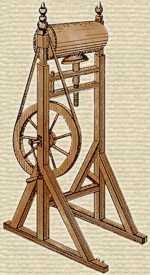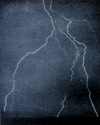 (source)
(source)
|
Alexander George McAdie
(4 Aug 1863 - 1 Nov 1943)
American meteorologist who followed Benjamin Franklin in employing kites in the exploration of high altitude air conditions. He was second director of the Blue Hill Meteorological Observatory.
|
FRANKLIN'S KITE EXPERIMENT WITH MODERN APPARATUS.
By ALEXANDER McADIE.
[p.739] THE recent improvements in kites have suggested perhaps to many the question, “How would Franklin perform his kite experiment to-day?” It may seem a little presumptuous to speak for that unique philosopher, and attempt to outline the modifications he would introduce were he to walk on earth again and fly kites as of yore; for, with the exception of Jefferson, perhaps his was the most far-seeing and ingenious mind of a remarkable age. But the world moves; and in making kites, as well as in devising electrometers and apparatus for measuring the electricity of the air, great advances have been made. Franklin would enjoy repeating his kite experiment to-day, using modern apparatus. What changes and lines of investigation he would suggest are beyond conjecture.
A hundred and fifty years ago a ragged colonial regiment drew up before the home of its philosopher-colonel and fired an ill-timed salute in his honor. A fragile electrical instrument was shaken from a shelf and shattered. Franklin doubtless appreciated the salute and regretted the accident. In the course of his long life he received other salutes, as when the French Academy [p.740] rose at his entrance; and he constructed and worked with other electrometers; but for us that first experience will always possess a peculiar interest. The kite and the electrometer betray the intention of the colonial scientist to explore the free air, and, reaching out from earth, study air electrification in situ. He made the beginning by identifying the lightning flash with the electricity developed by the frictional machine of that time. A hundred patient philosophers have carried on the work, improving methods and apparatus, until to-day we stand upon the threshold of a great electrical survey of the atmosphere. It is no idle prophecy to say that the twentieth century will witness wonderful achievements in measuring the potential of the lightning flash, in demonstrating the nature of the aurora, and in utilizing the electrical energy of the cloud. The improved kite and air-runner will be the agency through which these results will be accomplished.
The famous kite experiment is described by Franklin in a letter dated October 19, 1752: “Make a small cross of light sticks of cedar, the arms so long as to reach to the four corners of a large, thin silk handkerchief when extended. Tie the corners of the handkerchief to the extremities of the cross, so you have the body of a kite which, being properly accommodated with a tail, loop, and string, will rise in the air like those made of paper, but being made of silk is better fitted to bear the wet and wind of a thunder gust without tearing. To the top of the upright stick of the cross is to be fixed a very sharp-pointed wire rising a foot or more above the wood. To the end of the twine next the hand is to be tied a silk ribbon, and where the silk and twine join a key may be fastened. This kite is to be raised when a thunder gust appears to be coming on, and the person who holds the string must stand within a door or window, or under some cover, so that the silk ribbon may not be wet; and care must be taken that the twine does not touch the frame of the door or window. As soon as the thunder clouds come over the kite, the pointed wire will draw the electric fire from them, and the kite, with all the twine, will be electrified, and stand out every way and be attracted by an approaching finger. And when the rain has wet the kite and twine you will find the electric fire stream out plentifully from the key on the approach of your knuckle.”
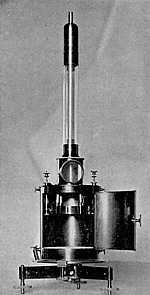
[p.741] Now, how would we perform this experiment to-day and with what results? Having flown big kites during thunderstorms, it may perhaps be best to describe step by step two of these experiments, and then speak of what we know can be done, but as yet has not been done.
Our first repetition of Franklin's kite experiment was at Blue Hill Observatory, some ten miles southwest of Boston, one hundred and thirty-three years after its first trial. There were two large kites silk-covered and tin-foiled on the front face. These kites were of the ordinary hexagonal shape, for in 1885 Malay and Hargrave kites were all unknown to us. Fifteen hundred feet of strong hemp fish line were wrapped loosely with uncovered copper wire of the smallest diameter suitable, and this was brought into a window on the east side of the observatory, through rubber tubing and blocks of paraffin. Pieces of thoroughly clean plate glass were also used. Materials capable of giving a high insulation were not so easily had then as now. We knew very little about mica; and quartz fibers and Mascart insulators could not be obtained in the United States. Our electrometer, however, was a great improvement upon any previous type, and far removed from the simple pith-ball device used by Franklin.
Knowing that an electrified body free to move between two other electrified bodies will always move from the higher to the lower potential, Lord Kelvin devised an instrument consisting of four metallic sections, symmetrically grouped around a common center and inclosing a flat free-swinging piece of aluminum called a needle. The end of the kite wire is connected with the needle and the sections or quadrants are alternately connected and then electrified, one set with a high positive potential, say five hundred volts, and the other with a corresponding negative value, say five hundred volts lower than the ground.
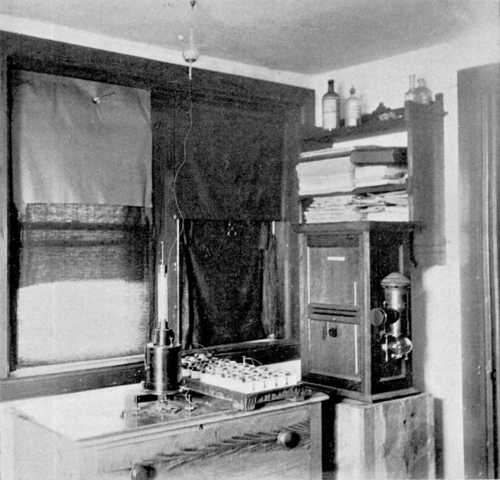
Blue Hill Meteorological Observatory.
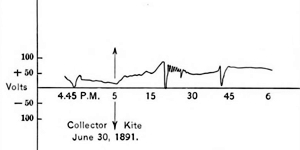
Small collector about fifteen feet from ground; kite about five hundred feet from ground.
Passing now over six years in which we had been busy measuring the electrification of the air under all conditions, and discovering, for example, that a snowstorm was almost identical with a thunderstorm in its tremendous electrical changes, we come to the year 1891, when we again flew kites for the purpose of electrically exploring the air. Our experiments at the top of the Washington Monument in 1885 and 1886 (especially those during severe thunderstorms, when we obtained potentials as high as three and four thousand volts just before the lightning), had given us an insight into the strains and stresses in the air, and taught us what to expect at such times. There was still little improvement in the kite, but much better electrical apparatus [p.744] was at hand. It may seem ridiculous, but we hauled nearly a wagon-load of electrical apparatus to the summit of the hill, and found occasion to use all of it. Our insulators were delicate glass vessels, curiously shaped, containing sulphuric acid, and able to hold with little leakage the highest known potentials. Besides these fine Mascart insulators, we had hundreds of distilled-water batteries and two electrometers, one a Mascart quadrant, the other a large multiple quadrant. The chief aim that year was to secure by mechanical means (discarding the photographic and eye methods) a continuous record of the potential. When we can study the potential at any moment and still have a record of it, the relation of the electricity of the air to the pressure, temperature, and moisture will be more easily investigated. Among our records that year there is one date, June 30, 1891, where a direct comparison of the electrification of the air fifteen or twenty feet from the ground and at a height of about five hundred feet is shown. In one, the potential was obtained by a water-dropper collector from a second-story window in the observatory, and in the other was obtained by means of the kite. It will be seen how much higher the kite values are, although the kite was a much slower accumulator of electricity.
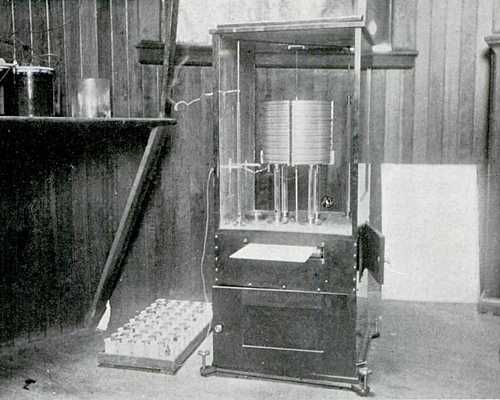
Blue Hill Observatory.
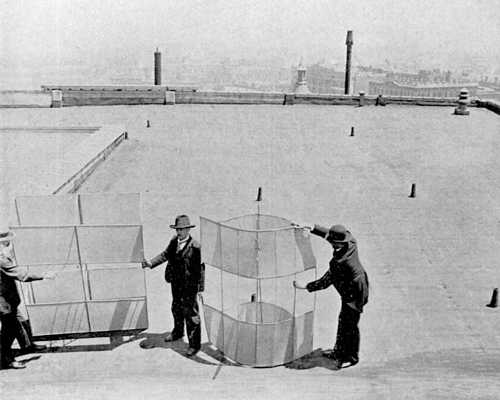
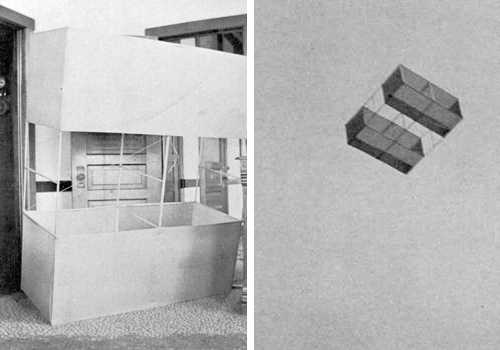
This year, in some interesting experiments made on the roof of the Mills Building at San Francisco, it was noticed that the roof, which has a covering of bitumen, was a good insulator. Ordinarily one may touch the reel on which the kite wire is wound without being shocked, but if a wire be connected with the ventilating pipes running to the ground there are small sparks. Introducing a condenser in the circuit, the intensity of the spark is increased. It only remains to construct an appropriate coil of the kite wire and place within it another independent coil. In the outer coil a quick circuit breaker may be placed, and theoretically at least we shall transform down the [p.747] high potential and low amperage charge of the air to a current of less potential and greater amperage. This can be put to work and the long-delayed realization of Franklin's plan of harnessing the electricity of the air be consummated. It may not be a profitable investment from the commercial standpoint, but no one can say what this tapping of the aerial reservoir may lead to. Determining the nature and origin of the aurora will be as great a scientific achievement as utilizing the energy of Niagara Falls.
- 4 Aug - short biography, births, deaths and events on date of McAdie's birth.
- Articles written by Alexander McAdie
- Theory and Practise of Frost Fighting - article by Alexander McAdie from Scientific Monthly (1915)
- Needless Alarm During Thunderstorms - article by Alexander McAdie from Century Magazine (1899).
- The Storage Battery of the Air - article by Alexander McAdie from Harpers New Monthly Magazine (1894).
- What is an Aurora - article by Alexander McAdie from The Century Magazine (1897).
- Muir of the Mountains - Alexander McAdie writing about John Muir in Sierra Club Bulletin (Jan 1916).
- Making the Weather, by Alexander G. McAdie. - book suggestion.
